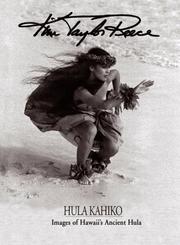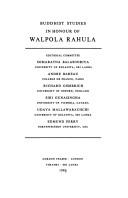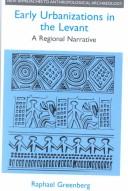| Listing 1 - 7 of 7 |
Sort by
|
Book
ISBN: 3839436699 9783839436691 9783837636697 3837636690 Year: 2016 Publisher: Bielefeld
Abstract | Keywords | Export | Availability | Bookmark
 Loading...
Loading...Choose an application
- Reference Manager
- EndNote
- RefWorks (Direct export to RefWorks)
Monika Lilleike's performance analytic study on Hawaiian Hula `Olapa reveals how this genuine performing art practice shapes and transmits oral history via a distinct set of performative means of framing and stylization. The intermedial confluence of performance elements, sound, body and words instills an oscillating effect of multisensory experience which echoes a deep rooted sense concerned with place, distinct environmental features, and story line. The study appeals to discussions on intermediality, metaphoricity, and to an anthropology of the senses. It outlines practice as research and embodied knowledge as tools to conduct performance analysis. Besprochen in: Mitteilungen der Anthropologischen Gesellschaft in Wien, 147 (2017), Hermann Mückler
Hula (Dance) --- Hula-Hula (Dance) --- Dance --- Performance; Oral Poetry; Stylization; Hula; Hawaii; Embodied Knowledge; Practice As Research; Theatre; Dance; Body; Theatre Studies; Dance Studies; Aesthetics --- Aesthetics. --- Body. --- Dance Studies. --- Dance. --- Embodied Knowledge. --- Hawaii. --- Hula. --- Oral Poetry. --- Practice As Research. --- Stylization. --- Theatre Studies. --- Theatre.
Book
ISBN: 9781407305714 1407305719 Year: 2010 Volume: 2095 Publisher: Oxford Archaeopress
Abstract | Keywords | Export | Availability | Bookmark
 Loading...
Loading...Choose an application
- Reference Manager
- EndNote
- RefWorks (Direct export to RefWorks)
Pottery, Prehistoric --- Excavations (Archaeology) --- Neolithic period --- Céramique préhistorique --- Fouilles (Archéologie) --- Néolithique --- Hula Valley --- Hula, Vallée du --- Antiquities. --- Antiquités --- Pottery --- Céramique préhistorique --- Fouilles (Archéologie) --- Néolithique --- Hula, Vallée du --- Antiquités

ISBN: 0966039599 Year: 1997 Publisher: Sacred Falls : Kim Taylor Reece Gallery,
Abstract | Keywords | Export | Availability | Bookmark
 Loading...
Loading...Choose an application
- Reference Manager
- EndNote
- RefWorks (Direct export to RefWorks)
Photographie de danse --- Hula (danse) --- Reece, kim taylor --- Ouvrages illustres --- Photographies --- Photographie de danse --- Hula (danse) --- Reece, kim taylor --- Ouvrages illustres --- Photographies

ISBN: 0860920305 Year: 1980 Publisher: London Fraser
Abstract | Keywords | Export | Availability | Bookmark
 Loading...
Loading...Choose an application
- Reference Manager
- EndNote
- RefWorks (Direct export to RefWorks)
Buddhism. --- Buddhism --- #SML: Joseph Spae --- S37/0650 --- Buddha and Buddhism --- Lamaism --- Ris-med (Lamaism) --- Religions --- Buddhism outside China, Tibet, Mongolia and Japan--Buddhist theory and study --- Rahula, Walpola. --- Appuhamy --- De Silva, Hettigoda Gamage Don Hendrick --- Punchi Malli --- Rāhula, Valpoḷa Śrī --- Rāhula, Walpola --- Rahula, Walpola Sri --- Rahura, Wŏlpʻora --- Rakhula, Valpola --- Valpola Rakhula --- Valpoḷa Śrī Rāhula --- Walpola Sri Rahula --- Wŏlpʻora Rahura

ISBN: 1283192624 9786613192622 056711600X 9780567116000 9781283192620 0718502302 9780718502300 6613192627 Year: 2002 Publisher: London New York Leicester University Press
Abstract | Keywords | Export | Availability | Bookmark
 Loading...
Loading...Choose an application
- Reference Manager
- EndNote
- RefWorks (Direct export to RefWorks)
Early Urbanizations in the Levant examines the first cycle of urbanization, collapse and reurbanization in the 4th-2nd millennium BCE Levant. The core of the study is a detailed analysis of settlement fluctuations and material culture development in the Hula Valley, at the crossroads between modern Israel, Syria and Lebanon. Focusing on field data and a close reading of the material text, the book emphasizes the variety exhibited in patterns of cultural and social change when small, densely settled regions are carefully scrutinized. Using the concepts of time-space edges and shifting loci of p
Urbanization --- Cities and towns, Ancient --- Land settlement patterns, Prehistoric --- Prehistoric land settlement patterns --- Geography, Ancient --- Cities and towns, Movement to --- Urban development --- Urban systems --- Cities and towns --- Social history --- Sociology, Rural --- Sociology, Urban --- Urban policy --- Rural-urban migration --- Hula Valley (Israel) --- ʻEmeḳ ha-Ḥulah (Israel) --- ʻEmeḳ Ḥuleh (Israel) --- ʻEmeq Hula (Israel) --- Hulah Valley (Israel) --- Hule Valley (Israel) --- Antiquities. --- Israel --- Hula Valley --- Cities and towns [Ancient ] --- Land settlement patterns [Prehistoric ] --- Antiquities
Book
ISBN: 0520276647 0520957210 9780520957213 1299974597 9781299974593 9780520276635 0520276639 9780520276642 Year: 2014 Publisher: Berkeley
Abstract | Keywords | Export | Availability | Bookmark
 Loading...
Loading...Choose an application
- Reference Manager
- EndNote
- RefWorks (Direct export to RefWorks)
This first major examination the interrelationships of music and surfing explores different ways that surfers combine surfing with making and listening to music. Tim Cooley uses his knowledge and experience as a practicing musician and avid surfer to consider the musical practices of surfers in locations around the world, taking into account ideas about surfing as a global affinity group and the real-life stories of surfers and musicians he encounters. In doing so, he expands ethnomusicological thinking about the many ways musical practices are integral to human socializing, creativity, and the condition of being human. Cooley discusses the origins of surfing in Hawai'i, its central role in Hawaiian society, and the mele (chants) and hula (dance or visual poetry) about surfing. He covers instrumental rock from groups like Dick Dale and the Del Tones and many others, and songs about surfing performed by the Beach Boys. As he traces trends globally, three broad styles emerge: surf music, punk rock, and acoustic singer-songwriter music. Cooley also examines surfing contests and music festivals as well as the music used in a selection surf movies that were particularly influential in shaping the musical practices of significant groups of surfers. Engaging, informative, and enlightening, this book is a fascinating exploration of surfing as a cultural practice with accompanying rituals, habits, and conceptions about who surfs and why, and of how musical ideas and practices are key to the many things that surfing is and aspires to be.
Music --- Surf music --- Surfing --- Body surfing --- Surf riding --- Surfboard riding --- Surfboarding --- Surfriding --- Aquatic sports --- Surf rock --- Rock music --- Music and society --- Social aspects. --- History and criticism. --- History. --- america. --- beach boys. --- cultural practices. --- del tones. --- dick dale. --- ethnomusicologists. --- ethnomusicology. --- genre studies. --- global surfers. --- hawaiian society. --- hula. --- human socializing. --- instrumental rock. --- mele. --- music and culture. --- music festivals. --- music genres. --- music scholars. --- music studies. --- musical practices. --- musicians. --- punk rock. --- singer songwriters. --- surf movies. --- surf music. --- surfers. --- surfing contests. --- surfing culture. --- surfing music. --- surfing origins. --- surfing.
Book
ISBN: 9781847011787 1847011780 1782044280 1847011101 1322988846 Year: 2017 Publisher: Oxford James Currey
Abstract | Keywords | Export | Availability | Bookmark
 Loading...
Loading...Choose an application
- Reference Manager
- EndNote
- RefWorks (Direct export to RefWorks)
From 1550 to colonial partition in the mid-1880s, trade was key to Afro-European relations on the western Slave Coast (the coastal areas of modern Togo and parts of what are now Ghana and Benin). This book looks at the commercial relations of two states which played a crucial role in the Atlantic slave trade as well as the trade in ivory and agricultural produce: Hula, known to European traders as Great or Grand Popo (now in Benin) and Ge, known as Little Popo (now in Togo). Situated between the Gold Coast to the west and the eastern Slave Coast to the east, this region was an important supplier of provisions for Europeans and the enslaved Africans they purchased. Also, due to its position in the lagoon system, it facilitated communication along the coast between the trading companies' headquarters on the western Gold Coast and their factories on the eastern Slave Coast, particularly at Ouidah, the Slave Coast's major slave port. In the 19th century, when the trade at more established ports was disrupted by the men-of-war of the British anti-slave trade squadron, the western Slave Coast became a hot-spot of illegal slave trading. Providing a detailed reconstruction of political and commercial developments in the western Slave coast, including the transition from the slave trade to legitimate commerce, this book also reveals the region's position in the wider trans-Atlantic trade network and how cross-cultural partnerships were negotiated; the trade's impact on African coastal 'middlemen' communities; and the relative importance of local and global factors for the history of a region or community. Silke Strickrodt is Research Fellow in Colonial History, German Historical Institute London. She is co-editor (with Robin Law and Suzanne Schwarz) of Commercial Agriculture, the Slave Trade and Slavery in Atlantic Africa (James Currey, 2013).
325
| Listing 1 - 7 of 7 |
Sort by
|

 Search
Search Feedback
Feedback About UniCat
About UniCat  Help
Help News
News